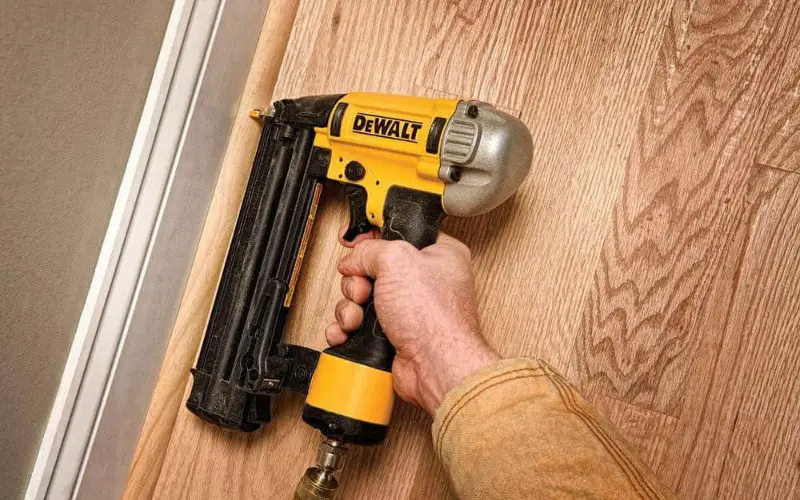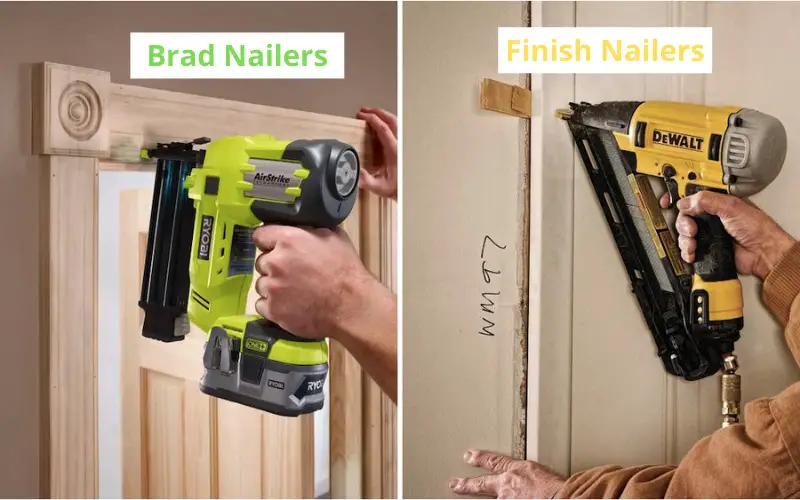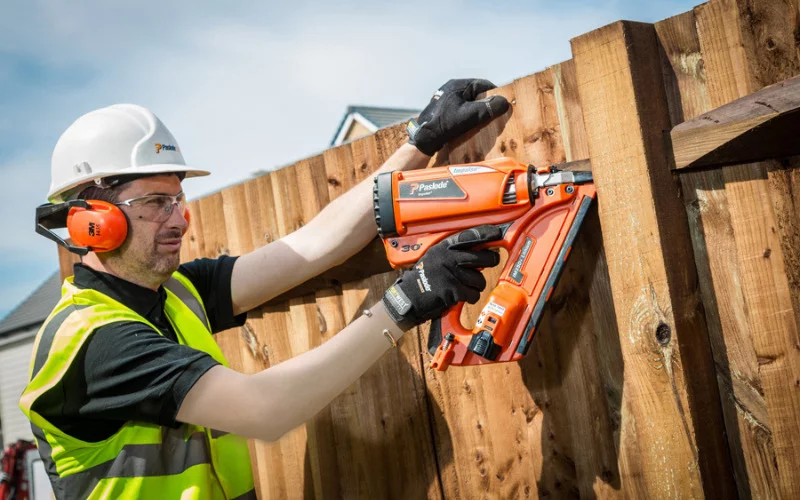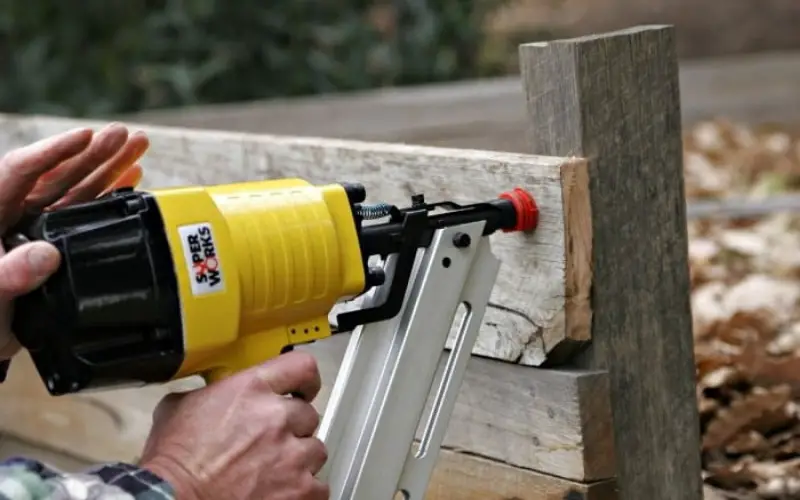Building a fence can be tough, but it can be made easier using tools like a nailer. A nailer helps you stick your nail into hard surfaces without difficulty.
There are different nailers, and each type can be used for different purposes. Some of the popular types of nailer include the Brad nailer, framing nailer, and finish nailer. And if you have one of these, you are probably wondering, “Can I use a finish nailer for fencing?” Or vice versa.
This article will explain what a finish nailer is, and we will also look at a brad nailer. We will explain how to use a finish nailer for fencing.
What are Finish Nailers?

Finish nailers are designed to drive larger nails like 16-gauge, 15-gauge, and even 14-gauge nails. “Gauge” is used to classify nails according to their size, measured by their diameter.
The higher the number, the thinner the nail, and the thicker the nail, the more the holding power.
These nails are thick and very in height at about 1 to 3½ inches; Finish nailers possess the required amount of force needed to drive in these thick nails.
15-gauge trailers shoot in thick nails that vary in length between 1 to 3 inches; their thickness gives them more holding power.
15-gauge nails can be used to shoot nails through materials like wood for doors and other materials that require good holding power.
16-gauge trailers shoot nails that are slightly thinner than the 15- gauge nails. They have a diameter of ¾ inches and a length that varies between 2 – ½ inches; their holding power is good and can be used for general purposes. You may get 14-gauge nailers that are very thick and have excellent holding power.
What are Brad Nailers?

Brad nailers are used to shooting relatively thinner nails like 18-gauge nailers and 23-gauge nails. These nails have weak holding power and are best used to hold materials that are not very thick, like fixing window casing and other minor woodworks.
Nailers can be pneumatic or cordless. Cordless nailers are powered by a battery, while pneumatic nailers are powered by compressed air. Pneumatic nailers are reliable as they are easy to maneuver, lightweight, and fast.
What is Framing Nailers
Framing nailers are designed to shoot larger and stronger nails with a diameter between 113” to 131” and height between 1-¼ inches to 3-½ inches.
The nailer provides an extremely strong nailing power to hold thick surfaces together.
Framing nailers are ideal for large flooring, roofing, and fencing projects. It is used when plaster is involved in construction because manual hammering can cause the plaster to crack.
Can I Use a Finish Nailer for Fencing

Finish nailers provide nails of various lengths, but unfortunately, this nailer can not be used to hold up a fence. A good and sturdy fence requires exterior instruction nails for this task. This is because the nails need to be weather resistant.
In place of a finish nailer, you can use a framing nailer or a drill and exterior construction nails for your fence. A fence held together by a finish nailer will not last long, especially during harsh climate conditions. Finish nailers are ideal for cabinets, interior doors, dressers, and exterior staircase.
How to Use a Nailer for Fencing?
Building a fence can be difficult, especially if it’s your first time doing such a demanding task. To make your work in fencing easier, it is important to make a plan and learn the basics of fencing before diving staring into the building.
You should also have a design in mind and gather your tools beforehand. Below are some of the materials needed for fencing.
Materials needed
- Fence posts
- Railing
- Framing nailer
- Concrete mix
- Shovel
After gathering all your materials, you should follow these steps to build a sturdy and stable fence.
Step one
Measure and mark out the areas where your fence posts should be. This will organize and make your work easier.
Step two
Once you have marked and measured the area for your fence post, start digging to create holes. The depth of the hole should be ⅓ the height of the post, and the width of the hole should be three times the diameter of your post.
Step three
Pour in your concrete mix into the hole and soak it with water. After soaking your concrete, submerge your fence post into the hole.
Allow your post to set for some hours before the next step. If you don’t have a concrete mix, you can mix one yourself using a hand shovel.
Step four
After your fence has been installed, use a level to endure that each post is straight and aligned together. You can proceed by attaching your railing. The top and bottom railing should always be attached first.
Step five
Use a framing nailer to attach the railing to the fence post. Be sure that your railings are aligned properly.
Step six
After attaching the first two railings, measure out a reasonable interval between the railings. You can have your railings close together or some distance apart.
You can use wood or mesh wires to build your fence; these materials have their advantages and drawbacks, the decision to use any of these materials is based on preference.
Conclusion
If you have a hard nailer or a finish nailer, you probably wonder if you can use it for fencing. While you can use the finish nailer for fencing, you won’t have a sturdy and stable fence as construction nails are needed for fencing.
Brad nailers shoot out thin nails that cannot be used for fencing but Interior constructions.
A better nailer for fencing is a framing nailer; It shoots out thicker nails with more holding power. We also provided a guide on building a fence and the materials needed for this process.
Helpful Links:
- Can You Put a Chiminea on Decking?
- How To Anchor a Metal Swing Set?
- How to Keep Patio Umbrella from Spinning
- How To Waterproof A Mattress For Outdoors
- Allen Roth Lighting Idea, Fixtures & Complete Guide
We trust this article helped you know if you can use a finish nailer for fencing. You may also want to check out the 10 Best Anti Slip Stair Treads for Outdoor Use.
Thanks for taking the time to read our article, and we hope you find it helpful. Would you mind leaving a comment below if you have any suggestions?
Kindly reach out to people by sharing this post on social media.
If you liked this article, then please follow us on Facebook, Instagram, and Pinterest.

